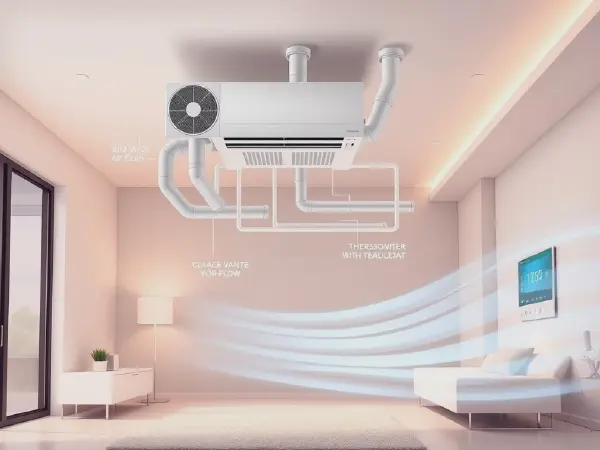Comprehensive Guide to Ducted Air Conditioning Systems

Understanding Ducted Air Conditioning: A Comprehensive Guide
Ducted air conditioning is a popular cooling and heating solution for homes and commercial buildings, offering an efficient way to regulate indoor temperatures. This system utilizes a network of ducts to distribute conditioned air throughout the space, ensuring a comfortable environment for all occupants. Unlike traditional window or portable units, ducted air conditioning systems are discreetly installed within the building, making them a favorable choice for aesthetics and comfort.
One of the key features of ducted air conditioning is its ability to provide consistent temperature control across multiple rooms. The system typically includes a central unit that cools or heats the air, which is then channeled through ducts and strategically placed vents. This type of air conditioning is not only effective in creating a comfortable living atmosphere but also allows homeowners to manage their energy usage more effectively, unlike some standalone systems that may leave certain areas overheated or underheated.
Managing comfort with ducted air conditioning is enhanced by zoning capabilities, allowing homeowners to adjust the temperature in different areas of their home according to their needs. This feature can lead to significant energy savings, as areas that are not in use can be kept at a lower temperature, reducing overall energy consumption. Additionally, ducted air conditioning systems can support both heating and cooling functionalities, making them a versatile solution for year-round comfort.
The efficiency of ducted airconditioning systems can significantly lower energy bills while maintaining optimal indoor comfort.
Ducted air conditioning systems are recognized for their aesthetic appeal—their discreet installation means that no bulky units are visible within living spaces, providing a cleaner and more spacious feel. The flexibility in design allows for various types of installations, whether in new builds or retrofits. This system can seamlessly integrate into a variety of home styles while delivering excellent performance, thus making it a preferred option for many homeowners.
In summary, ducted air conditioning combines efficiency, comfort, and aesthetic appeal, making it a popular choice among homeowners. With the ability to control temperatures effectively and efficiently, ducted systems can create a pleasant indoor climate while maintaining energy efficiency and promote the overall value of the property.
Benefits of Ducted Air Conditioning
Energy efficiency is a significant advantage of ducted air conditioning systems. These systems are designed to provide a controlled and even temperature throughout the space, minimizing the energy wasted on heating or cooling gaps. Properly zoned systems allow for energy use adjustments based on occupancy, which can result in lower energy bills.
Improved indoor air quality is another benefit of ducted air conditioning. These systems often include high-quality air filtration systems that remove dust, allergens, and pollutants from the air, creating a healthier environment for occupants. Regular maintenance ensures these filters operate effectively, contributing to better overall air quality.
Investing in a hydronic heating system not only enhances warmth but also promotes a clean and efficient home environment.
Comfortable temperature control throughout the home is a hallmark of ducted air conditioning. Unlike window units that may cool one room while leaving others untouched, ducted systems provide uniform temperature distribution, allowing for a consistently comfortable atmosphere in every room, regardless of exterior weather conditions.
The aesthetic appeal and design flexibility of ducted air conditioning systems make them an attractive choice. Installed within ceilings and walls, they do not obstruct viewlines or interfere with interior design. This means homeowners can enjoy effective climate control without compromising the visual integrity of their spaces.
Installation of Ducted Air Conditioning
Choosing the right system for your home is crucial when installing ducted air conditioning. Factors to consider include the type and layout of your property, the size of the space that needs conditioning, and your budget. Consulting with a professional can help you select a system that meets your specific needs rather than a one-size-fits-all solution.
Steps for professional installation typically start with an assessment of the home or building to create a customized plan. This includes laying out ductwork, selecting the right tools and equipment, and ensuring adequate ventilation. The installation process may take from a few hours to a couple of days, depending on the complexity of the system and the size of the property.
Cost factors influencing installation can vary widely based on the system selected, the size of the property, and any additional features such as zoning capabilities. It’s important for homeowners to consider both the upfront costs and the long-term savings due to energy efficiency when making a decision.
Common installation challenges may include limited space for ductwork, ceiling heights, or existing structures that impede the installation process. Solutions often involve creative duct placement or using alternative technologies such as ductless mini-splits for hard-to-reach areas, ensuring the system is effective without compromising home design.
Maintenance of Ducted Air Conditioning Systems
Regular cleaning and filter replacement are crucial for maintaining the efficiency of ducted air conditioning systems. Homeowners should regularly inspect and replace filters, typically every few months, depending on usage and environmental factors. Additionally, maintaining clean ducts and vents prevents airflow restrictions and enhances overall system performance.
Signs your system needs maintenance can include unusual noises, reduced airflow, inconsistent temperatures, or increased energy bills. If any of these symptoms occur, it may indicate an issue that requires attention to restore optimal performance.
DIY maintenance tips include regularly cleaning or replacing filters and making sure that vents and ducts are free from obstructions. Homeowners can also schedule regular check-ups or tune-ups to keep the system running smoothly and catch any potential issues early on.
When to call a professional technician includes any instance when problems persist despite DIY efforts, or if there are signs of leaks, electrical issues, or significant drops in performance. Experts can perform detailed inspections and repairs to restore reliable operation.
Types of Ducted Air Conditioning Systems
Split system vs. multi-split systems are two common types of ducted systems. A split system typically includes one external unit connected to one internal unit, while a multi-split system can connect multiple indoor units to one outdoor unit, allowing for more flexible zoning across larger homes or buildings.
Zoning options and their advantages allow users to control temperatures in distinct areas or rooms, enhancing comfort and potentially reducing energy usage. This is particularly beneficial in homes with diverse heating and cooling needs across different rooms based on usage patterns.
Reverse cycle vs. cooling-only systems provide options for homeowners depending on their climates and requirements. Reverse cycle systems allow for both heating and cooling, making them suitable for regions with variable temperatures, while cooling-only systems may be adequate in consistently warm climates.
Smart technology integration in ducted systems has become increasingly common, providing homeowners with the ability to control their systems remotely via mobile devices or to program schedules for increased efficiency. This modernization adds convenience and can enhance energy savings over time.
Troubleshooting Ducted Air Conditioning
Common issues and their solutions with ducted air conditioning may involve airflow problems, thermostat issues, or system leaks. Troubleshooting steps involve inspecting filters, adjusting the thermostat, or checking for visible signs of leaks or blockages in ducts.
Tips for improving system performance include keeping vents unblocked, using shades or curtains to reduce heat gain during warmer months, and ensuring regular maintenance is performed to prevent significant problems from occurring.
Understanding your system's error codes can assist in troubleshooting potential issues. Many modern systems are equipped with indicators or codes that can guide users in identifying and resolving specific malfunctions by referring to user manuals or online resources.
When to seek expert help should be determined when symptoms persist or escalate despite troubleshooting efforts. Expert technicians can diagnose and repair more complex mechanical or electrical issues that may affect performance.
